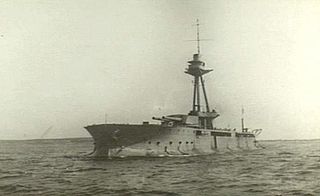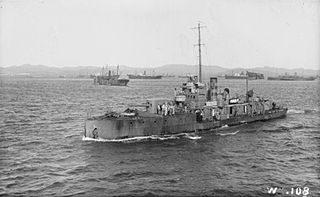
HMS Raglan was a First World War Royal Navy Abercrombie-class monitor, which was sunk during the Battle of Imbros in January 1918.

HMS Abercrombie was a First World War Royal Navy Abercrombie-class monitor.

HMS Havelock was an Abercrombie-class monitor of the Royal Navy that saw service in the First World War.

HMS M30 was a Royal Navy M29-class monitor of the First World War.
HMS M32 was an M29-class monitor of the Royal Navy.
HMS M27 was a First World War Royal Navy M15-class monitor. She was also served in the British intervention in Russia in 1919, and was scuttled in the Dvina River on 16 September 1919.

HMS Welland was a Yarrow-built River-class destroyer ordered by the Royal Navy under the 1902 – 1903 Naval Estimates. Named after the River Welland that drains into the Wash on the English east coast, she was the first ship to carry this name in the Royal Navy.
HMS M25 was a First World War Royal Navy M15-class monitor. She was also served in the British intervention in Russia in 1919, and was scuttled in the Dvina River on 16 September 1919.
HMS Colne was a Thornycroft type River-class destroyer ordered by the Royal Navy under the 1903–1904 Naval Estimates. Named after the River Colne in eastern England, north east of London, she was the first ship to carry this name in the Royal Navy.

HMS Arun was a Laird Type River-class destroyer ordered by the Royal Navy under the 1902–1903 Naval Estimates. Named after the River Arun in southern England she was the first ship to carry this name in the Royal Navy.
HMS Moy was a Laird Type River-class destroyer of the Royal Navy. Named after the River Moy in Ireland, she was the first ship to carry this name in the Royal Navy.
HMS Ness was a White Type River-class destroyer ordered by the Royal Navy under the 1903 – 1904 Naval Estimates. Named after the River Ness in northern Scotland, flowing through Inverness, she was the first ship to carry this name in the Royal Navy.
HMS Nith was a White Type River Class Destroyer ordered by the Royal Navy under the 1903–1904 Naval Estimates. Named after the River Nith in southern Scotland, on the West Coast, she was the first ship to carry this name in the Royal Navy.

HMS Ribble was a Yarrow-type River-class destroyer ordered by the Royal Navy under the 1901 – 1902 Naval Estimates. Named after the River Ribble in northern England, she was the first ship to carry this name in the Royal Navy.

HMS Usk was a Yarrow type River Class destroyer ordered by the Royal Navy under the 1901 – 1902 Naval Estimates. Named after the River Usk in Wales flowing through Newport, she was the first ship to carry this name in the Royal Navy.

HMS Erne was a Palmer Type River Class Destroyer ordered by the Royal Navy under the 1901 – 1902 Naval Estimates. Named after the River Erne in Ireland, she was the third ship to carry this name since it was introduced in 1813 for a 20-gun brig sold in 1819.
HMS Cherwell was a Palmer Type River-class destroyer ordered by the Royal Navy under the 1902 – 1903 Naval Estimates. Named after the River Cherwell in south central England near Oxford, she was the first ship to carry this name in the Royal Navy.

HMS Chelmer was a Thornycroft-type River-Class destroyer ordered by the Royal Navy under the 1903–1904 Naval Estimates. Named after the River Chelmer in eastern England, north-east of London, she was the first ship to carry this name in the Royal Navy.
HMS Jed was a Thornycroft type River-class destroyer ordered by the Royal Navy under the 1903 – 1904 Naval Estimates. Named after the River Jed in southern Scotland, she was the second ship to carry this name since it was introduced in 1814 for a 26-gun sixth rate ship sold in 1833.
HMS Dee was a Palmer Type River Class Destroyer ordered by the Royal Navy under the 1901–1902 Naval Estimates. Named after the River Dee near Liverpool, England, she was the fourth ship to carry this name since it was introduced in 1814 for a 20-gun 6th rate sold in 1819.










